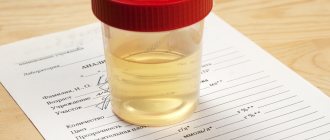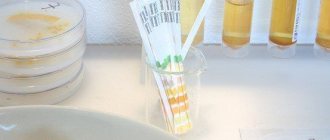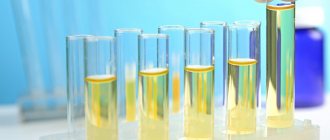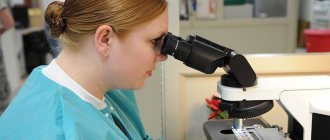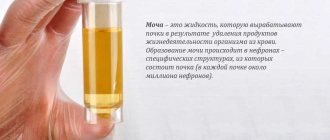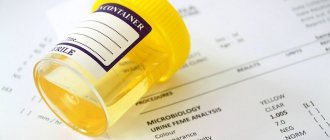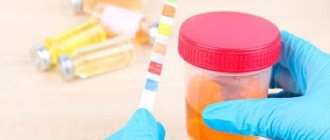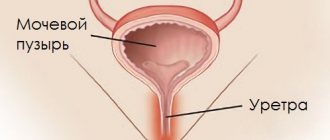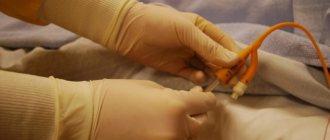Examination of urine includes determination of its physical and chemical properties and microscopic examination of its composition.
Urinalysis is widely used in medicine to diagnose pathological changes in the urinary system, as well as as an additional study of diseases of the endocrine, cardiovascular, circulatory and digestive systems of the body. General clinical urine analysis is widely used , which allows one to obtain general data on the state of the excretory system.
If it deviates from the norm, narrow tests aimed at diagnosing a specific pathology are additionally prescribed.
Indications for urine analysis
The content of the article
Urine is a product of the excretory system, including excess fluid, salts, proteins, sugars, blood cells and epithelium (integumentary tissues), etc. The human body gets rid of urine to maintain the balance of chemical compounds, salts and water. When health problems arise, the composition of urine begins to change. Various microorganisms appear in it, indicating the appearance of a urinary tract infection. All these deviations are revealed by urine analysis.
The doctor issues a referral for a urine test for various reasons: he wants to examine the genitourinary system for inflammation and infections, determine whether there is blood and sugar in the urine, and clarify the composition and concentration of salts. Referral to OAM should not be a cause for concern. This is a common procedure that is recommended for children and adults to undergo annually. The patient is also sent for a urine test if:
- diseases of the genitourinary system;
- inflammation of the liver and gallbladder;
- metabolic disorders;
- diseases of the male reproductive system;
- sexual infections;
- toxicosis of pregnant women;
- hepatitis;
- diabetes;
- intoxication of the body with poisons and drugs;
- problems with the kidneys or bladder.
If the doctor, based on a number of signs, suspects the presence of pathologies and abnormalities, then a urine test helps confirm or refute his guesses. After treatment, the doctor prescribes a repeat test, which will show how effective it was.
Daily biochemical analysis
The collection of biomaterial is carried out over 24 hours in a special sterile container. This method is quite informative. With its help it is possible to determine:
- Daily amount of urine (deviations from accepted results may indicate intoxication, for example, with mercury).
- The presence of substances such as: potassium (for hormonal imbalance);
- calcium (for metabolic disorders, adrenal cortex dysfunction);
- chlorine or sodium (for diabetes, kidney dysfunction);
- ketone bodies or acetone (for severe disturbances in the functioning of internal organs);
- albumin (for kidney problems in diabetes);
- uric acid (diagnosis of gout);
- amylase (indicators of pancreatic function).
How to properly prepare for tests
Everyone has had to undergo a urine test , more than once, but the doctor is not always able to convey to the person information about the rules of preparation for this procedure in an accessible and competent way. Compliance with the recommendations affects the accuracy of the result obtained. Even the slightest ingress of foreign substances into the sample for analysis makes it impossible to obtain accurate data.
Proper preparation for the test includes several recommendations
- On the day before donating urine, you should avoid foods that contain dyes and cause color changes: beets, carrots, carbonated water.
- If medication treatment cannot be interrupted, be sure to notify your doctor. He will advise you to complete the course and then take the test. If the urine test is urgent, it is possible to interrupt treatment on the eve of the test.
- Avoid eating salty foods, dietary diuretics and multivitamins. They are able to change the properties and concentration of urine.
- If a urine test is scheduled a few days after a ureteroscopy or cystoscopy, it would be better to reschedule it. There is also no need to collect urine during menstruation. This will make the research result biased.
- On the day before the analysis, it is not advisable to visit a sauna or bathhouse, then a lot of fluid is released from the human body and the urine becomes more concentrated.
Please note some rules that must be taken into account when collecting morning urine:
- You need to collect urine in the morning; do not store urine that was collected a day ago or at night.
- Use a special disposable container, and for newborns you can buy a urine bag at the pharmacy.
- There is no need to remove the urine of a child or a bedridden patient from a diaper or diaper by squeezing it. Fabric fibers caught in it will distort the results of the study.
- Before collecting urine, be sure to perform genital hygiene.
Other types of analyzes
In addition to the general examination, other types of more detailed urine analysis may be prescribed. They are specific types of urine studies and allow you to study its composition in more detail and identify certain pathologies.
Analysis according to Nechiporenko
The Nechiporenko method makes it possible to diagnose hidden urinary pathologies. It is based on determining the number of formed elements per unit volume of urine.
For research, a urine sample of 50-100 ml is taken. It is placed in a centrifuge for 10 minutes. After this, the liquid contents are drained. In the concentrated contents, red blood cells, white blood cells and casts are counted. The resulting figure is multiplied by 250.
If the number of leukocytes exceeds 2000 per 1 ml, then the patient most likely develops prostatitis, inflammation of the bladder or pyelonephritis and kidney stones.
If the number of red blood cells exceeds 1000 per 1 ml, the patient is at high risk of developing renal infarction or glomerulonephritis.
Normally there are no cylinders. Their presence, even in minimal quantities, indicates kidney disease. Depending on the nature of the disease, they may have granular, hyaline, waxy or other forms.
Analysis according to Zimnitsky
This method refers to advanced tests that are prescribed to assess the functioning of the kidneys and identify deviations in their functioning. It is carried out in a hospital setting and requires compliance with the rules for collecting urine, while there are no restrictions on food and liquid intake.
Sample collection:
- Between 6 and 7 a.m. you should urinate, i.e. no overnight sample needed;
- starting from 9 am, you should collect urine in a certain jar every three hours. In total, you need to fill 8 containers (at 9, 12, 15, 18, 21, 24, 3 and 6 hours);
- on the leaflet for each jar you should indicate the volume of liquid you drink during this period of time;
- you don’t have to endure it, the jar can be filled several times;
- After filling the jar, you should immediately put it in the refrigerator;
- if at any time there is no urge to go to the toilet, then the jar is left empty;
- If a large amount of urine is released during a period and one jar is not enough, you need to take an additional one. Pouring urine into the toilet is prohibited;
- After the last urine collection at 6 am, all samples with signatures must be submitted to the laboratory.
The study evaluates indicators such as urine density, daily volume and its distribution at different times. Based on their results, the doctor identifies kidney or heart failure, diabetes mellitus, poisoning, etc.
Analysis according to Amburge
This method is based on studying the amount of blood in urine. It allows you to more accurately identify a particular kidney pathology.
Before taking the test, in addition to the general rules for collecting urine, it is necessary to exclude liquid overnight. After limiting your drinking, you should completely empty your bladder. Time it. You are allowed to eat and drink without restrictions for three hours. After this time, you need to collect a urine sample and immediately submit it to the laboratory
During the study, red blood cells and white blood cells are counted, which settle in 1 minute. If the number of red blood cells exceeds 1000, it indicates glomerulonephritis. When the leukocyte value is more than 2000, chronic pyelonephritis is detected.
Analysis using the Kakovsky-Addis method
According to the Kakovsky method, the patient is required to collect a daily volume of urine and deliver it to the laboratory. This method allows us to identify the dynamics of the appearance of blood cells in urine throughout the day.
In general analysis they are not always identified, because stand out unevenly. The method allows you to clarify kidney diseases such as pyelonephritis, glomeloronephritis, urolithiasis or polycystic kidney disease.
Glucose test
Such a study is prescribed if there is an imbalance in the carbohydrate balance in the body. It allows you to identify pathologies in organs such as the adrenal glands, pancreas or thyroid gland, as well as diagnose diabetes mellitus.
The study requires a 10 ml portion of morning or daily urine. The norm is considered to be an indicator of the presence of sugar in the range of 0.06-0.083 mmol/l.
Protein analysis
A protein test allows you to assess the functional state of the kidneys. Normally, protein should be absent from urine.
Impaired filtration and absorption in the kidney tissues lead to large amounts of protein entering the urine. This occurs during acute inflammatory processes, infections, decreased immunity or severe poisoning.
Rehberg's test
This test allows you to track creatinine levels. It is not absorbed by the kidneys and is completely eliminated from the body. If kidney function is impaired or there is a hormonal imbalance, the amount of creatinine in the urine is significantly reduced. An increase in the indicator indicates diabetes mellitus or hypertension.
At the same time as the urine test, a blood test is taken to compare the indicators. The normal level of creatinine can range from 5.3 to 17.7 mmol/l.
Uric acid test
Uric acid is synthesized in the liver and excreted through the urinary tract. When kidney function is impaired, acid metabolism is disrupted and it accumulates in the blood and joints. This phenomenon is typical for gout, pancreatitis or urolithiasis.
For analysis, a collected portion of daily urine of 100 ml is taken. The acid content ranges from 1.4 to 4.3 mmol/day.
Determination of hCG level
This study serves as an express method and is carried out to detect pregnancy in the early stages. On the 4th day after fertilization, the tissues of the embryo begin to secrete a special hormone - human chorionic gonadotropin. Determining the concentration of the hormone in urine is possible 7-10 days after conception. The test requires a morning urine sample.
Sulkovich test
The analysis allows you to determine the calcium content in the urine. A large amount of calcium indicates that it is poorly absorbed by the body. This condition may indicate pyelonephritis, diabetes mellitus, urolithiasis, osteoporosis, etc.
Methods for collecting urine for general analysis
Urine for general analysis
It is collected in a clean jar in the morning immediately after sleep. Before collection, you need to wash your genitals with soap. Next, urine collection occurs. Tests are not prescribed during menstruation.
The most common option involves collecting an average portion of urine in a container. The first portion goes down the toilet, then the container is replaced. In this case, urination is not interrupted. In the second case, you need to collect all the morning urine in a clean container. Then the required amount is poured into the container. This method is much more informative and allows you to obtain objective data on the condition of the genitourinary system.
The results of the study are recorded on a special form indicating the patient’s personal data. With this document you can go to the doctor for a diagnosis.
How to collect urine for analysis depending on its type
- Urine according to Nechiporenko
is collected in the same way as for general analysis. The average portion is 100-150 ml. In the laboratory, the number of leukocytes, erythrocytes and other elements is counted. - For urine analysis according to Zemnitsky
, urine is collected every three hours in a separate jar, the first container is filled at 6.00. All containers are taken to the laboratory, because in this study, the change in urine density during the day is determined and its total excretion is calculated. - A three-glass test
is prescribed when you need to find out the localization of inflammation in the genitourinary tract. To do this, collect all the morning urine, dividing it into three portions. An increased number of leukocytes in all jars indicates inflammation of the kidneys or bladder, in the first - urethritis, in the first and third - a combination of urethritis and prostatitis.
Please note: urine is sent to the laboratory within two hours after the end of collection.
Collection, storage and delivery of biomaterial
In order to obtain the most reliable data and eliminate the possibility of repeated testing, you need to know how to properly submit urine for general analysis and follow the rules for storing and transporting urine to the laboratory. Normally, a healthy person's urine is sterile. Bacteria can enter it by passing through the urinary tract, from the surface of the genitals, or from contaminated containers.
Collecting biological fluid is an intimate process that is not difficult, so it can be done independently. As a rule, children, seriously ill people or bedridden patients need help. It is possible to obtain urine from a baby only after breastfeeding, since the process of saturation and emptying is closely interrelated. If urine does not come out, you can massage your tummy or take a warm foot bath. These measures can lead to reflex urination. In boys, due to the peculiarities of their anatomical structure, it is easier to obtain a sample - just insert a test tube. For girls, it is worth purchasing a soft container with a sticky edge for secure fixation.
To successfully collect biological material, adults must prepare properly and follow the following algorithm of actions indicated in the leaflet issued by the doctor.
- The procedure is performed in the morning immediately after waking up, on an empty stomach, before washing
- It is recommended that the last emptying of the bladder be carried out 5-6 hours before collection.
- Before urinating, you should toilet the genitals using a soap solution, then rinse and wipe dry. In this case, it is recommended for a man to rinse the head of the genital organ and the external opening of the urethra, for a woman - the perineal area.
- The first few drops (10-20 milliliters) should be flushed down the toilet, since they may contain particles of epithelium that can distort the result. A medium portion should be collected in a container. If you do not know exactly how much urine is needed for analysis, approximately 50-100 ml should be collected.
- If home containers are used for collection, they must be thoroughly washed in advance, scalded with boiling water, or better yet, sterilized and dried. The neck of the container should be wide and the lid should close tightly. The ideal option is a plastic container, which can be purchased at any pharmacy.
- Urine should be collected in containers prepared specifically for this purpose. You should not take it from a pot, duck, or urinal. Moreover, there is no need to pour it, shake it, or mix it.
- Material collected in the morning and stored for no more than 60-90 minutes is considered valid for analysis. It is during this period that the urine must be delivered to the laboratory.
- In one day, stop eating foods that can affect the color of urine; chocolate and alcohol are strictly prohibited. You need to stop taking medications, even vitamin complexes. If for any reason it is impossible to interrupt the course of treatment, you should notify your doctor.
Advice! Girls and women should know that during menstruation they should refrain from taking a test, since menstrual blood can get into the container with urine and affect the reliability of the result. If the examination needs to be carried out urgently, the entrance to the vagina should be blocked with a cotton swab. Pregnant women should do the same, since a small amount of secretion or mucus may get into the urine.
Decoding urine analysis: norms for adults and children
During this examination, the specific gravity, pH of urine (urine), its color and transparency are measured. During a microscopic examination of the sediment, the number of leukocytes and erythrocytes is determined, and the presence of sand, protein and sugar is detected.
Only the attending physician who has information about the patient’s health status can decipher the result obtained. The normal values for adults and children are slightly different.
Urine test norm for adults
| Criterion to be assessed | Norm |
| Color | Straw yellow, light yellow transparent |
| Transparency | Full |
| pH | Neutral |
| Density (specific gravity) | 1,018-1,025 |
| Osmolarity | 600-800 mmol/l |
| Glucose | No |
| Acetone | No |
| Protein | No |
| Red blood cells | No |
| Ketone bodies | No |
| Leukocytes | For women: 0-5 in the field of view, for men: 0-3 |
Normal urine test for a child
| Criterion to be assessed | Norm |
| Smell | Unsharp |
| Color | From light yellow to dark yellow |
| Transparency | Full |
| Specific gravity | 1,010-1,025 |
| pH | 5-7 |
| Glucose | Up to 1 mmol/l |
| Protein | Up to 0.14 g/l |
| Ketone bodies | 0-0.5 mmol/l |
| Bilirubin | Up to 8.5 µmol/l |
| Bacteria | No |
| Hemoglobin | No |
| Bacteria (nitrite test) | No |
| Urobilinogen | Up to 35 µmol/l |
| Leukocytes | 0-5 in sight |
| Red blood cells | 0-2 in sight |
| Cylinders | No |
| Epithelial cells | 0-5 in sight |
| Yeast mushrooms | No |
| Parasites | No |
| Crystals | Are visualized |
How to collect a urine sample
The process of collecting urine plays a major role in the reliability of urine testing. Failure to comply with collection rules can lead to the introduction of bacteria or other particles into the sample, which leads to distorted results.
The basic rules for collecting a urine sample are:
- requires a urine sample collected early in the morning, immediately after sleep;
- First of all, you need to take a shower;
- you need to take the middle portion and pour out the rest;
- The sample must be collected in a sterile container or a specially prepared jar (thoroughly washed, sterilized and dried);
- To test the child’s urine, a sample is collected using a special urine bag;
- After collection, the sample must be brought to the laboratory within 2 hours (if stored for a long time, it becomes unusable and pathogenic organisms and bacteria begin to multiply in it).
In addition, there are certain conditions of the body when it is recommended to postpone the test - high blood pressure, high body temperature or menstruation. In the latter case, if there is an urgent need for testing, the woman must use a tampon during the sample collection process.
Evaluation of urine test indicators
Urinalysis involves the assessment of physicochemical, biochemical properties and microscopy of urinary sediment.
Physicochemical characteristics
Such properties are considered to be the color and smell of urine, its quantity, chemical reaction and specific gravity. The color of urine is determined by the presence of dyes in it. At the same time, by changing the shade, you can determine the presence of pathologies and diseases of the internal organs of a person.
Normally, urine is clear, but if turbidity is observed, this is a sign of excess salts, mucus, bacteria, fatty particles or epithelial cells in the urine.
A characteristic odor can be felt after long-term storage of liquid in a closed container, especially at high temperatures. It is also possible to diagnose certain diseases by smell.
The chemical reaction of urine is affected by the patient's diet. A slightly acidic or neutral reaction is considered normal. A sign of kidney problems is a markedly acidic pH level. A deviation from the norm also indicates heart failure, gastrointestinal diseases, infectious diseases, or simply pregnancy.
An alkaline reaction appears with vomiting, pathologies of the endocrine system, use of diuretics, kidney diseases, heart and lung diseases.
The density or specific gravity of urine is determined taking into account the amount of compounds such as pigments, glucose, proteins, blood elements and bacteria, and is normally 1.001-1.040 g/l.
The amount of urine is determined by the amount of liquid drunk per day and varies between 1-2 liters. The only disease in which the patient can excrete more than 8 liters. urine per day - diabetes mellitus. In other cases, frequent urination, especially at night, is a clear sign of kidney pathologies, cystitis, prostatitis, prolapse (prolapse) of the genitourinary system, which is often found in women, or mental disorders.
Biochemical indicators
These data are very important in the process of diagnosing diseases. They give an idea of the content of proteins, ketone bodies, glucose, acetone, bile pigments and other compounds in the urine.
A healthy person does not have protein in their urine. Its presence is called proteinuria. The reasons for this phenomenon may be different:
- Extrarenal: protein from the urinary tract enters the urine.
- Renal: protein penetrates from the blood plasma under the influence of stress, cold or overwork, as well as during kidney inflammation.
Normally, glucose is also practically absent and is not detected by standard research methods (biochemistry, OAM): its concentration does not exceed 0.06 - 0.083 mmol/l. If it is detected, this indicates excessive consumption of carbohydrates (physical glycosuria). Glucosuria of the pathological type is often caused by pathologies of the adrenal glands, diabetes mellitus or dysfunction of the pituitary gland.
Glucose is also normally absent. If it is detected, this indicates excessive consumption of carbohydrates (physical glycosuria). Glucosuria of the pathological type is often caused by pathologies of the adrenal glands, diabetes mellitus or dysfunction of the pituitary gland.
The presence of ketone bodies (acetone, beta-hydroxybutyric acid, acetoacetic acid) in the urine should alert you. This is a symptom of diabetes, inflammation of the liver and kidneys. In diabetes mellitus, the presence of ketone bodies is especially dangerous; the condition can lead to coma.
Microscopy of urinary sediment
This method allows you to determine the presence of blood elements in the urine: leukocytes, erythrocytes, casts and epithelial cells.
The presence of red blood cells in the urine is called hematuria. Macrohematuria is a large number of red blood cells in the urine. Microhematuria - red blood cells are noted only in the field of view under a microscope.
The presence of red blood cells indicates pathologies such as kidney stones, injuries and malignant tumors, kidney infarctions, tuberculosis, and inflammatory processes in the urethra.
The number of red blood cells in the urine is determined by three samples (three-glass test):
- Blood in all three samples: kidney pathologies.
- Blood only in the third sample: inflammation or tumor.
Cylinders are cells that are similar in shape to renal tubules. OAM can detect hyaline and epithelial cell casts. Hyaline casts indicate chronic nephritis, and epithelial cellular casts indicate pathology of the renal tubules (for example, nephrosis).
Epithelial cells in urine can be flat (formed on the mucous membranes of the genital organs), transitional (lining the inner surface of the renal pelvis and bladder), renal (found in kidney infections and poisoning).
Leukocytes in the urine are contained in small quantities in the field of view. If the doctor detects a collection of leukocytes under a microscope, then the presence of pus in the urine can be suspected. This condition is typical for pyelonephritis, purulent pathologies of the genitourinary system. The cause of the accumulation of pus in the urine can be identified using the three-sample method, as in the determination of red blood cells.
What does urine tell you?
The kidneys produce urine from blood plasma. In physiology, a distinction is made between primary and secondary urine.
The kidneys continuously filter the blood, approximately 300 times per day, for a total of one and a half thousand liters of blood passing through the body’s filters daily.
This process produces approximately 150 – 170 liters of primary urine.
Its composition is similar to blood plasma, with the exception of proteins, since the glomerular filter of the kidneys does not allow proteins to pass through, with the exception of approximately three percent of hemoglobin and a hundredth of a percent of albumin - the smallest proteins in the plasma.
Photo:
Primary urine contains vitamins, amino acids, electrolytes and other substances necessary for the normal functioning of the body.
It is further concentrated and filtered, important substances are absorbed back into the blood, and from there waste products enter the urine. The daily norm of secondary urine is one and a half liters.
The composition of urine can change due to failures at any stage of this long and difficult process.
Elements may appear that normally should not be present in the urine, or in significantly smaller quantities.
For example, white blood cells are normally present in extremely small quantities; an increase in their number indicates infections of the genitourinary system.
However, even in completely healthy people there are many leukocytes in the vagina and urethra (women and men, respectively), from where they can get into the material for analysis.
This is an example of how important personal hygiene is to a general urine test.
The amount of blood cells or biochemicals in the urine depends on various factors:
- age (the norm is different for children, adults and the elderly);
- nutrition, for example, the urine of people on a protein diet and mono-raw food eaters will differ in composition;
- physical activity, since lack of movement or increased physical activity will also affect the composition of urine.
READ Rules for collecting a 24-hour urine test
There are approximately five hundred parameters that can be determined by studying urine. Each of them will provide information about the functioning of the body or even serve as a symptom of various diseases.
In addition to diseases of the genitourinary system, urine analysis will help diagnose diseases of the cardiovascular and nervous systems, determine the condition of the skeleton, overdose or deficiency of vitamins and obtain a lot of other useful information.
Video:
Of course, urine can only be a source of information for a specialist who knows what he is looking for.
Therefore, between the patient and the laboratory that performs the tests, there must be an intermediary - a qualified doctor.
Urinalysis according to Nechiporenko
This procedure is considered as an additional method of examining urine in order to clarify the degree of leukocyturia (the number of leukocytes). Urinalysis according to Nechiporenko is prescribed when a general urine analysis reveals an excess of leukocytes and erythrocytes or laboratory technicians find cylinders in it.
For this analysis, an average portion of morning urine is used. A sufficient amount of liquid is 5 ml. The concentrate is obtained by centrifugation for 10 minutes. Then he is placed in Gorachev’s chamber, where the blood elements are counted. The resulting numbers are multiplied by 250 and a final number is obtained, by which a particular disease is determined:
- The number of leukocytes is more than 2000 in 1 ml of urine: prostatitis, inflammation of the bladder, kidney disease, pyelonephritis.
- The number of red blood cells is more than 1000 per ml: kidney infarction or glomerulonephritis (in the presence of a number of characteristic signs).
- Detection of casts: renal pathology.
As you can see, a urine test helps to detect various health problems in a timely manner.
Urine examination as a diagnostic method for detecting diseases
Urine is one of the main waste products of the body. The main component of the liquid presented is water; urine contains from 92 to 99% . It also contains decay products, toxic substances and toxins, which the body got rid of naturally. The presence of such components makes it possible to analyze the state of urine and determine whether a person has diseases.
Most often, donation of the presented liquid is prescribed for suspected diseases of the kidneys and urinary system. But there are also situations when urine is donated for preventive purposes.
How much does it cost to take a urine test?
The price of a urine test depends on the commercial direction of the clinic. In our laboratory you can donate urine at the lowest cost, while obtaining a high-quality, accurate result.
| Cost of analysis | price, rub. |
| General urine analysis with sediment microscopy | 325 |
| Urinalysis according to Nechiporenko | 275 |
| Sulkowicz test | 175 |
| Biochemical urine analysis | Price, rub |
| Rehberg test (endogenous creatinine clearance) | 415 |
| Total protein in urine | 240 |
| Calcium in daily urine | 285 |
| Albumin in urine (microalbuminuria) | 410 |
| Phosphorus in daily urine | 285 |
| Total amylase in daily urine | 280 |
| Uric acid in daily urine | 255 |
| Creatinine in daily urine | 255 |
| Magnesium in daily urine | 285 |
| Urea in daily urine | 255 |
| Potassium, sodium, chlorine in daily urine | 295 |
| Potassium in daily urine | 270 |
| Sodium in 24-hour urine | 270 |
| Chlorine in daily urine | 270 |
| C-peptide in daily urine | 635 |
| Glucose in urine | 205 |
Urine tests in children
What urine tests are there for children? In addition to the above types, children may be prescribed separate studies. For example, Sulkovich's test is performed when there is a suspicion of rickets. It helps control vitamin D overdose and calcium excretion in urine. At the moment, the method is rarely used. It is replaced by a biochemical urine test. Please understand that outcome measures may differ between children and adults. This depends on the fact that the child’s body is not yet fully formed and it is difficult to assimilate and digest some foods. However, the strong smell of acetone or the cloudy consistency of urine is a reason to consult a doctor.
Where to take a urine test in St. Petersburg
Private clinic Diana offers its patients to undergo any type of urine tests in our laboratory. We guarantee an accurate result that you won’t have to doubt. At the clinic you can consult a urologist and gynecologist and, if necessary, undergo additional examination.
CLICK TO MAKE AN APPOINTMENT, TEST OR ULTRASOUND
If you find an error, please select a piece of text and press Ctrl+Enter
Urine collection rules
- In the morning on an empty stomach.
- It's better not to go to the toilet all night.
- Before collecting, you should wash yourself so that foreign substances do not penetrate into the liquid.
- Use a clean and dry container.
- Do not eat foods that stain urinary fluid, such as carrots.
- Bring urea no later than 1.5 after collection.
- Before collecting, you should wash yourself so that foreign substances do not penetrate into the liquid.
Thus, we figured out what kind of urine tests there are. Today, laboratory institutions have a large number of them, which, in turn, makes it possible to conduct screening examinations of the patient in a short time. Only an experienced specialist is able to perform a high-quality interpretation of tests and assess the state of health based on a whole range of data.
Secondary clarifying analyzes
Secondary clarifying analyzes
As mentioned above, basic tests reveal the suspected presence of a particular disease. Further, so to speak, secondary (not important) studies are carried out to confirm or refute the diagnosis. The so-called functional tests include several types of urine tests; they have their own purposes and collection rules:
- Urinalysis according to Zimnitsky - suspicion of kidney inflammation or renal failure;
- Reberg's test - makes it possible to determine the ability of the kidneys to clear creatinine from the blood; a violation of this function is evidence of kidney damage;
- Sulkovich's test is a qualitative test for calcium content;
- Urinalysis for catecholamines - in most cases, changes in indicators indicate the presence of benign or malignant tumors, heart attack, etc.;
- A test for the presence of DPID in urine makes it possible to determine a marker of bone resorption and an indicator of bone tissue metabolism.
There are also a lot of specific samples that are taken in conjunction with other studies. In general, any test is designed to detect the presence of pathology or refute its presence.
